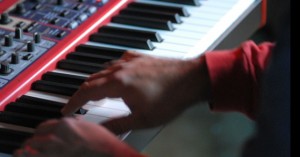New Ways to Use Dante
 Keyboard and Omnisphere multi track setup
Keyboard and Omnisphere multi track setup
by Jason Vandergrift
Dante has usual uses such as tracking from a console or routing between system processors. As Dante has really taken the stage for network audio transport, more and more uses are arising. One of the simplest ways to increase the quality of your sound is by eliminating D/A and D/A conversions. Tech Arts has experienced this in many ways from sound systems to recording splits. Simply taking a few conversions away adds clarity and phase coherency. So why not go further?
Keyboard players are increasingly using programs like Main Stage in their rigs, or as their only source of sound. Like using patches and Omnisphere out of a Macbook. So adding Dante is easy, right?Just run the network and route the output. But why not use multiple tracks out of Omnisphere? As an engineer I am always looking for ways to improve my mix. If I could have multiple tracks from the keyboard, why wouldn’t I? Whenever we use backing tracks for live music, more often than not, there are multiple keyboard stems. I would prefer to mix these tracks myself for my room and not the way the studio engineer mixed it down. So, rather then relying on the keyboard player to mix his patches, I prefer to blend them into my mix separately. So here is my setup:
I started with 6 channels. The goal was not to add channels to the musicians monitoring. Ideally there would be no change to the way the band sees the keyboard. So we took 3 stereo mixes from the keyboard players rig: 1 being only the piano patch, 2 being the pads, and the 3rd a mixdown of both (for monitoring in the musicians ears); all using Dante Virtual Sound Card. In this case, an Allen & Heath iLive was used at FOH. Latency maxed out at 1.1ms for the macbook. We immediately experienced better stereo imaging and increased clarity. The addition of different patches from the keyboard gave much more flexibility to the mix. I ended up treating each patch as a differant instrument or player. The plan is to escalate this method to more patches in the future.
All in all the setup took some time. The switch config has to be spot on. The reliability of Dante is dependent on proper switch configuration and proper clocking. Also the routing in MainStage needed to be configured the first few times with this setup. We had a DI standing by and ready to jump in. By the 3rd time we eliminated the DI and flew with Dante. It’s also really nice to just run an ethernet cable for the instrument, making setup really fast. Dante has proven to be reliable in this application and, given the increase in sound quality, we plan to continue with the setup.





